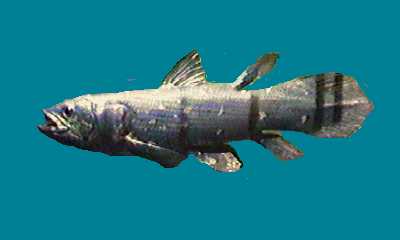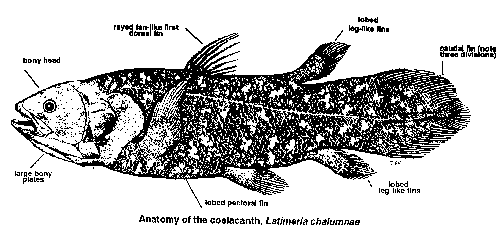pop up description layer
HOME
Cryptozoology UFO Mysteries Aviation Space & Time Dinosaurs Geology Archaeology Exploration 7 Wonders Surprising Science Troubled History Library Laboratory Attic Theater Store Index/Site Map Cyclorama
Search the Site: |
|
The Coelacanth
Professor James Leonard Brierley Smith stared at the page in disbelief. The day was January 3, 1939, and a letter had just arrived from a Miss Marjorie Courtenay-Latimer who was the curator at the East London Museum, South Africa. Courtenay-Latimer was writing to Smith, a South African chemistry professor who had taught himself ichthyology, to get his help in identifying a strange fish she had just obtained as a museum specimen, but could not find in her reference books. Even though the chairman of the museum's board of trustees dismissed the animal as just a "rock cod," she thought there was something special about it. The fish, reported Courtenay-Latimer, had been part of a catch made by the trawler Nerine off the South African coast near the Chalumna River on December 21st, 1938. The fish survived for several hours on the ship's deck, during which it snapped at the captain's hand. The captain, Hendrik Goosen, thought the five-foot long, pale blue animal was inedible, but decided to keep it for Courtenay-Latimer who often bought unusual fish for the museum's collection. Courtenay-Latimer almost didn't make the trek down to the docks that day because it was hot and she was busy, but she felt she should wish season's greetings to the ship's crew. It was fortunate she did. She saw the strange blue fish and, as she said later, declared it was "the most beautiful fish I had ever seen..." She bought the animal and proceeded to take it back with her. After an argument with a cabbie who didn't want to take the smelly carcass in his taxi, Courtenay-Latimer got it to the museum. However, once she was there she had no refrigeration facilities in which to keep such a large specimen and neither the local cold-storage warehouse or the mortuary would cooperate. Turning to a local taxidermist, she had the animal and its viscera preserved as best she could. Then she wrote Smith telling him the story and including a sketch of the unusual animal. Smith was at his vacation home in Knysna when the letter arrived. The letter, sketch included, sent his mind reeling. He knew exactly what type of fish it was based on the description. It was a coelacanth (pronounced 'seel-uh-kanth'), a member of a group of fish called the Crossopterygii. The only problem with this conclusion was that the coelacanth and the Crossopterygii had gone extinct some sixty-five million years before along with the dinosaurs.
It was imperative that Smith go in person to examine the specimen If he announced to the public that a live coelacanth had been discovered he would be the laughing stock of the ichthyological world if he was wrong. Unfortunately, commitments he could not break kept him away from East London until mid-February. Wanting to remain noncommittal, Smith wired Courtenay-Latimer the message "Save viscera...fish interesting." This gave Smith time to borrow a book from Dr. K. H. Barnard on the Crossopterygii and examine some scales Courtenay-Latimer sent him that had come off the fish when it was mounted. They looked like what he would expect from a member of the Crossopterygii family. Finally he arrived in East London on February 16th. Smith would later write in his book Old Fourlegs, The Story of the Coelacanth: "We went straight to the Museum. Miss Latimer was out for the moment, the caretaker ushered us into the inner room and there it was the - Coelacanth..." Smith was not prepared for his own reaction at the sight of the creature and he was so excited he began to shake. "Yes, there was not a shadow of a doubt, scale by scale, bone by bone, fin by fin, it was a true Coelacanth. It could have been one of those creatures of 200 million years ago come alive again." Smith named the fish Latimeria chalumnae in honor of Courtenay-Latimer who had spotted it and taken the time to preserve it. Smith, with the help of his wife, worked hard for four months to complete a scientific paper announcing the remarkable discovery to the world in June of 1939.
Despite the excitement of the find, the internal organs of the fish could had not been preserved for examination. Smith knew it was important to find another, intact specimen so it could be completely described. No more coelacanths were found off the coast of South Africa in the next ten years and Smith became convinced that the one that had been netted by the Nerine was a stray. Smith thought that the home grounds of the creature might be north near the Mozambique channel, so he had posters printed up in English, French and Portuguese with a drawing of the Coelacanth. The posters, which offered a reward of one-hundred pounds to anyone who could turn in a complete beast, were distributed in the surrounding area. In December of 1952 they got a cable from an acquaintance, Captain Eric Hunt, who was in the Comoros Islands, saying that he had gotten a hold of a coelacanth and was trying to preserved it for Smith with the small amount of formalin that he had. The fish had been caught by a man named Ahamadi Abdallah on the island of Anjouan. Abdallah was about to clean the fish he'd caught when a local teacher showed him one of the leaflets printed by Smith. There was a picture of the fish along with the instructions "Do not cut it or clean it or scale it, but take it at once to some responsible person." Legend has it that Abdallah dragged this 82-pound cargo twenty-five miles over mountains by foot, but in reality he probably hitched a ride on a truck. Once on the other side he presented it to Hunt, who recognized it as the fish Smith was seeking. Smith immediately wanted to travel to the Comoros, but there were no commercial airports and what private airfields there were had problems getting fuel. Smith was concerned knowing that the Comoros had no refrigeration facilities. He wasn't sure if Hunt had enough formalin to properly preserve the specimen in the heat. Also, since the fish had been caught on French soil there was a danger that it would be claimed by the French. Smith finally got the South African prime minister to give him a military plane for the trip. The plane landed and after an agonizing delay caused by a courtesy call on the governor, Smith got to Hunt's ship where he examined the specimen. Smith later admitted during a live radio program that he cried when he first saw the fish. Hours later he was on his way back home, through a torrential rain. Smith was right about the French. After he left, the government banned foreign scientists from collecting coelacanths for the next decade and a half. In 1991 scientists got a better understanding of the fish when Mike Bruton, of the JLB Smith Institute of Ichthyology joined with Hans Fricke, of the Max Planchk Instate to study the fish off the Comoros Islands. Fricke had built his own submarine so he could study the coelacanth in its natural habitat. The animal hides in underwater caves some 300 to 700 feet down during the day and comes out at night to feed. The class of fish to which the Coelacanth belongs to appeared some 400 to 350 million years ago. Scientists theorize that it is closely related to the first four-limbed land animals. Local Comoran fishermen had been aware of the carnivorous coelacanth (which is Greek for "hollow spine") for years before Smith's discovery, but since it was not edible they had not been interested in it, though it had been given the Comoran name Gombessa. Originally it was a concern that the Coelacanth might have a very limited range and that overfishing along the Comoros Islands might wipe it out. Scientists were amazed when in 1997 another coelacanth was discovered by an American scientist in Indonesia more than 6000 miles away from the Comoros. In October of 2000 divers off South Africa happened on three coelacanths in the St. Lucia Marine Protected Area. These findings suggest that the original fish caught by the Nerine was not a stray and that this "living fossil" may have a much wider range than was first thought. Also known as the Kombessa.
Illustration courtesy of South African Institute for Aquatic Biodiversity Copyright Lee Krystek 1996-2001. All Rights Reserved. |
|
Related Links |
|
|






